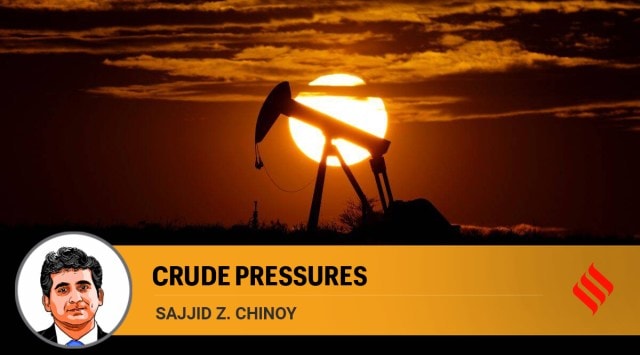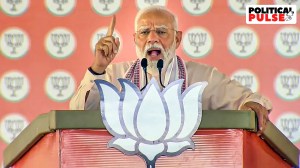- India
- International
Managing the crude price pressure
Sajjid Z. Chinoy writes: Surging oil prices constitute discernible terms of trade shock and will necessitate deft macro management
 Oil prices surged another $5 per barrel on Wednesday, March 2, 2022. (AP Photo/Eric Gay, File)
Oil prices surged another $5 per barrel on Wednesday, March 2, 2022. (AP Photo/Eric Gay, File)
Economic policymakers globally can’t seem to catch a break. 2020 witnessed the largest contraction since World War II. Just as economies began to recover, 2021 was the year of intransigent inflation. Just when markets began to internalise that the Fed may be on a rate hike spree, 2022 brings with it worrying geopolitical developments, with significant economic implications.
🗞️ Subscribe Now: Get Express Premium to access the best Election reporting and analysis 🗞️
Prima facie, there are several channels through which the Russia-Ukraine conflict will impact India’s economy, but it’s important to separate the wheat from the chaff. The first order impact, in our view, emanates from the negative terms of trade shock from higher commodity prices, particularly oil. To be sure, there are several other channels: A direct trade channel to the affected region, an indirect trade channel from weaker global growth, and a tightening of financial conditions and capital flows as global risk appetite wanes. These , however, can be expected to be more second-order vis-à-vis the commodity price shock.
Crude prices have surged well past a $110/barrel and though there will be an element of overshooting, there is a growing expectation that, as the conflict gets more entrenched, crude could remain elevated for much longer and average close to $100/barrel in 2022, vis-a-vis $70/barrel in 2021. This would constitute a large, negative terms of trade shock to India to the tune of 1.2 per cent of GDP. Put simply, the economy would be transferring out an incremental 1.2 per cent of GDP for the same net oil imports. The size of the commodity shock rises once higher prices for coal and gas imports are included.
Unfortunately, this is akin to an adverse supply shock to the economy that simultaneously impacts growth, inflation and the current account deficit (CAD). The growth impact will manifest through constraints on fiscal space, household purchasing power being impinged and firm margins coming under pressure. That said, the quantum of the growth impact will depend on how the shock is distributed across the fiscal, households and firms because of the different marginal propensities to consume. For example, the excise duty cuts last November have already absorbed about one-third of the shock from oil (0.4 per cent of GDP). The cost of this, however, is commensurate pressures on fiscal expenditures and growth, agnostically assuming a fiscal multiplier of 1. This year’s budget, therefore, forecasted lower excise duties collections but also had less spending space. In contrast, the marginal propensity to consume/invest out of income/earnings is typically lower than 1 for households/firms.

So, the greater the fraction of the shock absorbed on the fiscal, the greater the hit to demand and growth. This is not to suggest that policymakers should not consider any excise duties cuts, because higher retail prices could further harden inflationary expectations. However, when calling for fuel tax cuts this trade-off needs to be recognised. All told, the hit to growth in 2022 from oil at $100/barrel can be expected to be between 0.9-1.1 per cent of GDP depending on the burden-sharing between the public and private sectors.
Growth apart, oil at $100 will leave a tangible imprint on India’s external balances. The CAD averaged just 1.1 per cent of GDP in the seven years before the pandemic, helped by lower commodity prices, enabling large BoP surpluses and creating a “problem of plenty” for policymakers. But those dynamics are fast changing. The October-December CAD is tracking 3 per cent of GDP and the CAD is likely to stay close to those elevated levels in the coming quarters if crude is in triple digits. The RBI has a war chest of foreign currency reserves, so there is no imminent threat to macroeconomic stability. But the current account and balance of payments will need close monitoring, after a long time.
Finally, higher commodity prices can pressure inflation. 2022 was supposed to be the year that supply chains normalised and goods prices disinflated, offsetting rising services prices as the pandemic faded and consumers switched expenditures away from goods towards services. But if energy and other commodity prices remain elevated, firms will remain under pressure to eventually pass on input costs.
So how should policy respond in the wake of a terms of trade shock and what are the associated trade-offs?
Perhaps the clearest prescription is on the external front. The widening of the CAD and associated BoP pressures will create some depreciation pressures on the rupee. More fundamentally, a persistent negative terms of trade shock will argue for a weaker equilibrium real effective exchange rate. Policymakers should let the rupee reach this new equilibrium – albeit in a gradual and non-disruptive manner – and not prevent this adjustment because it will facilitate the necessary “expenditure switching” to reduce imports, boost exports and help narrow an elevated CAD. A real depreciation of the currency that acts as a shock absorber for the economy is the optimal response to a negative terms of trade shock.
That said, while a real deprecation can be expansionary, it can also be inflationary on account of a greater pass-through of imported prices and generating an aggregate demand boost in the wake of an adverse supply shock. All this will contribute to inflationary pressures, and will warrant a commensurate monetary policy response.
On the fiscal, there are no easy choices. Cutting excise duties would buffer the impact on households and protect consumption, but potentially result in a larger hit to demand by shrinking fiscal space to spend. If the government doesn’t cut duties, it has resources that can potentially be used to more directly target affected households at the bottom of the pyramid. But this will mean higher retail prices that can harden inflationary expectations, increasing the challenges for monetary policy. Finally, policymakers could always cut duties, not cut spending and let the deficit widen commensurately — effectively pushing out some of the terms of trade costs to the future — but negative surprises on the fiscal during periods of heightened macro uncertainty can generate significantly risk premia in markets. All told, the fiscal will confront several trade-offs, and should try avoiding corner solutions. What should be clear is that as soon as markets begin to stabilise, authorities must plough ahead with planned asset sales/disinvestment to create more fiscal headroom, without trying to perfectly time the market.
A persistent adverse supply shock is complicated and challenging to respond to, and the new equilibrium will inevitably need some combination of a weaker rupee, higher rates, and judicious fiscal management. Beyond the very near term, policymakers must seriously consider systematically hedging crude price imports in global markets to protect the economy from periods of outsized volatility, apart from the medium-term objective of reducing our dependence on imported crude.
For now, the key is to weather the storm. We can pick up the pieces when the clouds begin to clear.
This column first appeared in the print edition on March 4, 2022 under the title ‘Crude pressures’. The writer is Chief India Economist at J.P. Morgan. All views are personal
EXPRESS OPINION
Must Read
More Explained
Apr 27: Latest News
- 01
- 02
- 03
- 04
- 05












































